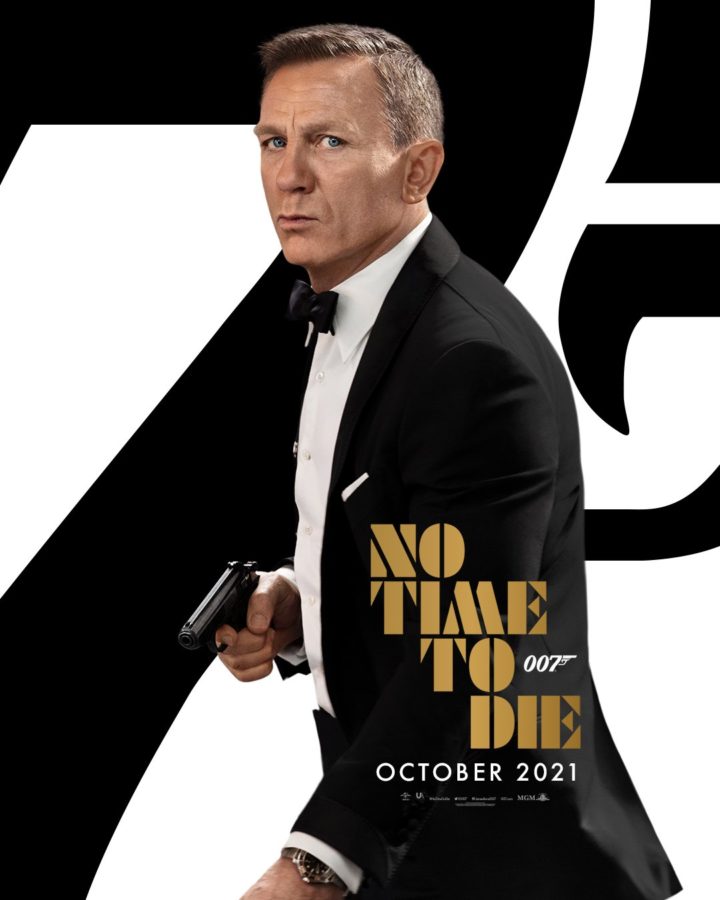“No Time to Die” delivers a fond farewell to Daniel Craig’s Bond
Daniel Craig returns as James Bond one final time, giving the character a definitive ending.
October 22, 2021
Secret agents. Devious villains. Dangerous women. Fast cars. Cool gadgets. Slick suits. Exotic locales. Bombastic setpieces. Thrilling escapes. Flashy title sequences. Vodka martinis, shaken not stirred. Bond, James Bond.
The elements of the “James Bond” film franchise are easy to recognize and have become iconic elements of popular culture. Since the British spy made the jump from Ian Fleming’s novels to the silver screen with 1962’s “Dr. No,” 007 has made himself a staple of our moviegoing lives for nearly 60 years. The second longest-running film franchise in history, the Bond series has pulled in generation after generation of fans as it continues to provide espionage fun over its now 25 installments. Through its time, the series has seen seven actors play the tuxedo-clad spy, with each tenure having markedly different styles of films throughout the franchise. From the archetypal Sean Connery, the tragic George Lazenby, the campy Roger Moore, the hard-edged Timothy Dalton to the suave Pierce Brosnan, each previous Bond and their respective films has had a different spirit to them—a key to the longevity of the series.
But no portrayal of James Bond has been quite like that of Daniel Craig. After the last Brosnan entry, 2002’s “Die Another Day,” proved to be a cinematic atrocity, the franchise needed a fresh start. At this point the tropes had become rote, with each film just going through the motions, and an odd gem here and there. The “Austin Powers” series and its satirical take on the Bond films didn’t help matters either, with the things that people once found so charming in them now objects of mockery. The franchise had long departed from being the cutting edge action franchise that it was during the 1960s Connery and Lazenby era, and it could never return to the camp and silliness of the others. With its age beginning to show, the only solution for Bond seemed to be a hard reset. And with Craig, a new beginning was found for the series.
For the first time, the series completely rebooted its continuity, starting from scratch with 2006’s “Casino Royale,” starring Daniel Craig as the latest iteration of James Bond. With his blonde hair and piercing blue eyes, Craig already looked unlike any previous 007 but his portrayal was what truly set him apart. The film shows Bond on his very first mission and thus is at liberty to explore his character more thoroughly. Through Craig, viewers found a vulnerable, unpolished yet ruthless killer. The film also eschewed the typical gadgetry and outlandish plots of the preceding films, with the most fancy device in the entire film being a defibrillator and a plot surrounding terrorist financing—a far cry from the invisible cars and the appearance-altering DNA reconstructions of “Die Another Day.” In many ways it was a back-to-basics approach, with the series trying to find the core elements that define the character.
The film was a smash success and the more realistic take on Bond’s character has since remained, though the films became progressively more like a classic bond film, integrating more larger-than-life elements. The third film in the Craig series, “Skyfall,” specifically deals with trying to reconcile series tradition with an evolving future, setting the groundwork for Craig’s 007 to delve more deeply into classical Bond elements. The intensely serialized nature of the Craig series has also been unlike any other portion of the franchise, with each installment building off each other, and 2015’s “Spectre,” specifically, trying to tie it all together. Now, with Craig announcing his retirement from the character, the story of this version of James Bond comes to a definitive end in the latest installment, the recently released “No Time to Die.”
“No Time to Die” was supposed to arrive in theaters in April 2020. That did not happen for obvious reasons, as this was one of the first films to be delayed due to the COVID-19 pandemic. Now with cases receding once more (fingers crossed), Bond is finally back for one last hurrah. Unique among Bond films, “No Time to Die” is the only one that has the opportunity to truly end Bond’s story, making Craig’s Bond the only one with a defined inception and conclusion. The film takes full advantage of this fact, with the entire 2-hour-43-minute runtime acting as a series of goodbyes to every aspect of Bond’s world that viewers had come to love.
The film starts almost immediately after the conclusion of “Spectre,” with Bond and his lover, Dr. Madeleine Swann (Léa Seydoux), starting a happy life together following Bond’s retirement. But there’s no rest for someone like Bond and disaster soon strikes once again, creating peril for the lovebirds. The first half feels like a classic Bond film, with action galore—such as a car chase through an Italian city and a shootout in a Cuban bar—and a plot involving an outlandish DNA-targeting assassin virus. But as the film goes on, the focus shifts from the bombast and more towards Bond’s personal journey. Tropes arrive then keep on getting inverted on their head. At one point Bond even leaves behind his Aston Martin to drive a Toyota Land Cruiser. Though the end does have Bond going to a villain’s secret lair to stop his end-of-the-world scheme—a very classic setup for the series—everything that happens once there subverts everything viewers expect from the series. From how the villain is dispatched to the final escape, all is unlike what you would anticipate.
Through it all, there are some incredible action sequences, with a scene where Bond is taking out several henchmen one-by-one in a foggy forest Rambo-style, and another where he marches up a stairwell mowing down baddies all filmed in a single shot, being the greatest highlights. The character moments vary in quality, with everything surrounding the central romance done effectively, as well as scenes involving saying goodbye to the supporting cast from all the previous films. The villain, on the other hand, Lyutsifer Safin (Rami Malek), makes for an incredibly confused character. His motivations are never quite made clear, and his obsession with Bond and Madeleine seems forced. But perhaps that was the point; by having the main villain be generally inconsequential to the overall emotional arc, the film maintains focus on Bond and his personal struggles. Megalomaniacs come and go and Bond continues in his work until the very end.
And now James Bond is gone—well this version at least. It is inevitable that James Bond will return in one form or another in the future. With Craig’s series mostly dealing with how to properly modernize the character for new audiences, the challenge becomes once again to discover what the enduring elements of the series are and how to make them applicable to a whole new generation. It will be tough, but the franchise has done it time and time again. As long as there is a world that needs saving, a James Bond adventure will always be welcome.



